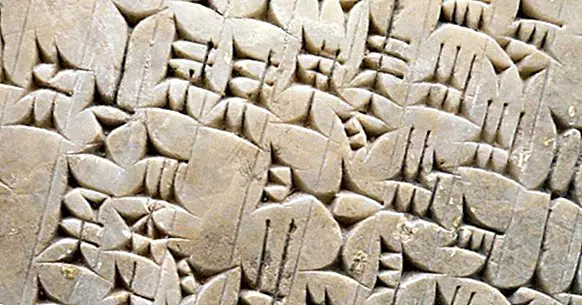History of writing: its development in Antiquity
Writing is both a practice and a system. It is about the graphic representation of ideas, concepts and objects by means of signs that we call letters. The latter may have different characteristics according to the specific society that uses them, which also generates different writing systems. One of them is, for example, the alphabet, and its history is very extensive, dating back more or less four centuries a.c.
In this article we will do a brief review of the history of writing , approaching the trajectory that has followed from classical Mesopotamia to the current western societies.
- Related article: "The 5 ages of History (and its characteristics)"
History of writing in Antiquity
Mesopotamia, the ancient region of the Near East, is recognized as the place where the beginnings of writing developed, which later gave rise to our current alphabetic system.
This process could be carried out by the multilingual and multicultural context that was characteristic of the area around the IV millennium BC. This is because that historical moment allowed the convergence of different ethnic groups. For the history of writing it was especially important the combination of Semitic languages with the language of the Sumerians, that was transmitted by means of pictograms that represented the objects.
- Maybe you're interested: "The 6 stages of Prehistory"
The cuneiform writing
The latter, the Sumerians, are credited with having created the cuneiform script. And this is because their pictograms were not simple graphic representations but they transmitted messages in a systematic way with linguistic value.
In addition, it is called "cuneiform writing" because, initially, the pictograms were made on clay tablets and by using wedges (pieces of wood or metal with tip and edge that serve to break or make incisions). In fact, the word "wedge" comes from the Latin word cuneus, and that is where the term "cuneiform" has come from.
Although the language of the Sumerians did not survive, cuneiform writing was a technique adopted by different Indo-European and non-Indo-European groups. For example, it was recovered by the Babylonians, but it also served to write languages such as Akkadian and Elamite. It was used by the Persians (people of Indo-European origin originally based in Iran), Hurrians (Mitanni people of Northern Mesopotamia), Hittites (people of the Anatolian peninsula, one of the powers of the Middle East).
So, writing as technique, and clay tablets along with wedges, as the main tools, they expanded throughout Asia Minor, Syria and surrounding areas . It is estimated that the cuneiform script was used for three and a half millennia and the last record of the cuneiform tablet is from 75 AD (Ferreiro, 1994).
Subsequently and through different historical events related to the way in which human settlements have been generated; cultural diversity and linguistic mix made possible the writing system initiated by the Sumerians arrived at the hands of the Hellenic peoples .
- Related article: "The development of reading and writing: theories and intervention"
Origins of the alphabet
The Greeks inherited from the Phoenicians and / or the Canaanites an ordered set of signs and symbols also associated with a name and a sound (what is known as the "principle of acrophony").
This ordered set of signs and symbols was assimilated and adapted by the Greeks for their own purposes. Specifically, it is the writing system called "protocananeo" (from the Bronze Age), which has been recognized as the paradigm from which the Phoenician alphabet was developed , which in turn laid the foundations for the development of the Latin, Greek, Hebrew alphabets, among others.
Writing, reading and literacy
The writing system that we know as alphabet is then the result of a pluri-literacy of the peoples conquered by the inhabitants of Ancient Greece, and arises as a result of the rich cultural and linguistic exchange.
The above means that the scribes of the time had strongly mixed alphabets, worked, used and mastered more than one language. Another consequence was that these alphabets were administered and distributed according to social systems, which is visible, for example, in the process of secularization of writing (when it stopped being a practice reserved for religious cults).
That is why, inevitably, the history of writing systems is linked to the history of literacy, while the latter is the process by which they control, use and distribute the discourses that should be written (Ferreiro, 1994) . In addition, while writing and texts do not exist without material support, the history of writing is also the history of reading, an issue that has recently been addressed by different linguists and historians.
Literacy followed a process of systematization and expansion that had different characteristics in the following historical moments of Western civilization, in a close relationship with print culture , the transmission of knowledge and education as practices and fundamental values for development.
Bibliographic references:
- Ferreiro, E. (1994). Diversity and literacy process: from celebration to awareness. Latin American Reading Magazine. 15 (3): 2-11.
- Laporte, J.P. (2012). Review of "History of Reading and Writing in the Western World" by Martins Lyons. Magazine information, culture and society. 27: 123-135.



















